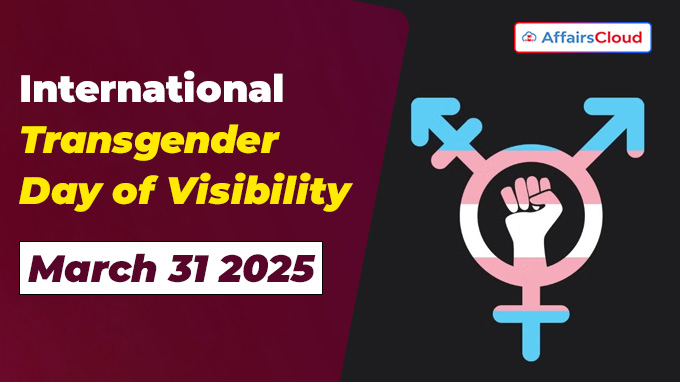 International Transgender Day of Visibility (TDOV) is annually observed across the globe on 31 March to celebrate the courage and resilience of transgender, nonbinary, and gender non-conforming persons and honours the contributions, achievements, and bravery of those people in every country and culture worldwide.
International Transgender Day of Visibility (TDOV) is annually observed across the globe on 31 March to celebrate the courage and resilience of transgender, nonbinary, and gender non-conforming persons and honours the contributions, achievements, and bravery of those people in every country and culture worldwide.
- The Day aims to increase awareness about the poverty, discrimination, and violence faced by the transgender communities and advocate for their rights and protection.
Transgender Flag:
i.Monica Helms, an American trans activist, created the design for the first transgender pride flag in 1999 as a symbol of trans diversity and rights.
ii.The flag represents the transgender community and consists of 5 horizontal stripes:
- The 2 pink and 2 blue stripes represent colours that have traditionally been associated with girls and boys
- The 1 white stripe represents people who are intersex, transitioning, or who don’t have a defined gender.
Background:
i.The International Transgender Day of Visibility was founded and organised in 2009 by Rachel Crandall Crocker, an American transgender activist.
- She is a licensed psychotherapist specialising in transgender issues and the Executive Director and Co-founder of TransGender Michigan based in Michigan, the United States of America (USA).
- She also runs Transgender Michigan helpline, the 1st transgender helpline in the USA.
ii.The 1st International Transgender Day of Visibility was observed on 31 March 2009.
Transgender:
i.The term “Transgender”, shortly called “Trans”, is an umbrella term for persons whose gender identity, gender expression, or behaviour does not conform to that typically associated with the sex to which they were assigned at birth.
- Gender identity refers to a person’s internal sense of being male, female, or something else.
- Gender expression refers to the way a person communicates gender identity to others through behaviour, clothing, hairstyle, voice, or body characteristics.
ii.They may identify as male, female, both, neither, or anywhere along the gender spectrum. Transgender individuals face numerous challenges globally, including:
- Social stigma and discrimination, lack of legal recognition, healthcare and educational barriers, housing instability, etc.
Legal Recognition in India:
i.The Supreme Court of India recognised transgender people as the “third gender” in the landmark National Legal Services Authority (NALSA) v. Union of India case (2014).
ii.In 2016, the Lok Sabha introduced the Transgender Persons (Protection of Rights) Bill, aiming to define transgender people, prohibit discrimination, and empower the transgender community.
- It was later passed with amendments in December 2018.
iii.In December 2019, the Government of India (GoI) passed the Transgender Persons (Protection of Rights) Act, 2019, which for the 1st time extended constitutional rights to persons identifying as transgender.
iv.The Transgender Persons (Protection of Rights) Rules, 2020, were formulated and published in the Gazette of India in September 2020.
v.The Ministry of Social Justice and Empowerment (MoSJE) launched the SMILE (Support for Marginalized Individuals for Livelihood and Enterprise) scheme in February 2022, comprising 2 sub-schemes:
1.Comprehensive Rehabilitation for the Welfare of Transgender Persons
2.Comprehensive Rehabilitation of Persons Engaged in Begging.
- This umbrella scheme covers several comprehensive measures, including welfare measures for both transgender persons and persons who are engaged in the act of begging.
Other Initiatives:
i.In 2020, the MoSJE launched a ‘National Portal for Transgender Persons’ and inaugurated a ‘Garima Greh: A Shelter Home for Transgender Persons’ in Vadodara, Gujarat.
ii.The portal helps a transgender person to apply for a Certificate and Identity Card (I-Card) digitally from anywhere in the country.
- It also helps them to get the I-Card without any physical interface.
Note: Tamil Nadu (TN) is pioneer State in India to form Transgender Welfare Board on 15 April 2008 to empower the Transgenders through various services.
Related Observance:
i.The Transgender Day of Remembrance (TDOR), also known as the International Transgender Day of Remembrance, is an annual observance on November 20 that honours the memory of transgender people whose lives were lost in acts of anti-transgender violence.
ii.TDOR was started in 1999 by an American transgender advocate, Gwendolyn Ann Smith, as a vigil to honour the memory of Rita Hester, a black transgender woman from Boston, Massachusetts (USA), who was killed in her apartment in 1998.




